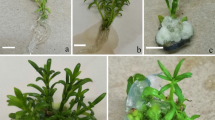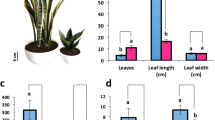Abstract
DURING the development of shoots of Helianthus tuberosus L. in sterile in vitro culture, swollen, ellipsoidal structures bearing scale leaves, and producing roots, were formed. These structures resemble, and are considered to be, tubers. The shoot cultures were derived originally from the growth of sterilized ‘eyes’ of tubers (artichoke strain P 17 of Nitsch and Nitsch1). From a leafy shoot growing in sterile culture, a section of stem 1 cm. long, including a single node with its pair of foliage leaves, was taken as explant, and was placed on a complex medium containing salts, 2 per cent sucrose, naphthalene-acetic acid (0.01 mgm./l.), casein hydrolysate, and coconut milk. The composition of the medium is given by Marsden and Wetmore2, except that cysteine and urea were omitted. When kept at 25° C. in a 12-hr, day at the relatively low light intensity afforded by pairs of fluorescent lamps and tungsten lamps at a distance of about 1 m., one or both axillary buds of the explant grew out into elongated shoots bearing foliage leaves (referred to hereafter as long shoots). Tubers were first noticed forming sporadically in such cultures, either at the base, or in the axils at recently formed nodes, or at the shoot apex. Fig. 1A shows a culture of the latter type, in which roots are forming abundantly from the tuber even though it is wholly in the air. The tubers would continue to grow if the entire culture, or the portion bearing the tuber, were transferred to new medium at intervals of about a month, and they could attain lengths of several centimetres; some, however, ‘bolted’ after transfer, that is, the apex grew out as a long shoot.
This is a preview of subscription content, access via your institution
Access options
Subscribe to this journal
Receive 51 print issues and online access
$199.00 per year
only $3.90 per issue
Buy this article
- Purchase on Springer Link
- Instant access to full article PDF
Prices may be subject to local taxes which are calculated during checkout
Similar content being viewed by others
References
Nitsch, J. P., and Nitsch, C., Amer. J. Bot., 43, 839 (1956).
Marsden, M. P. F., and Wetmore, R. H., Amer. J. Bot., 41, 640 (1954).
Mes, M. G., and Menge, I., Physiol. Plantarum, 7, 637 (1954).
Author information
Authors and Affiliations
Rights and permissions
About this article
Cite this article
RAY, M. Formation of Jerusalem Artichoke Tubers in Sterile Culture. Nature 181, 1480–1482 (1958). https://doi.org/10.1038/1811480a0
Issue Date:
DOI: https://doi.org/10.1038/1811480a0
Comments
By submitting a comment you agree to abide by our Terms and Community Guidelines. If you find something abusive or that does not comply with our terms or guidelines please flag it as inappropriate.



